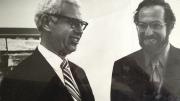The Art of Negotiation: How to Improvise Agreement in a Chaotic World, by Michael Wheeler, MBA Class of 1952 professor of management practice, retired (Simon & Schuster, $26). The author, mild-mannered in conversation, charismatic in the classroom, puts the emphasis on art, improvisation, and, as the first chapter title reemphasizes, “embracing chaos.”
An Uncertain Glory: India and Its Contradictions, by Jean Drèze and Amartya Sen, Lamont University Professor (Princeton, $29.95). India’s economic growth, the authors demonstrate, has been accompanied by persistent and widening inequality (of the 600 million people reported to have “lost” electricity in the July 2012 blackout, one-third never had power to begin with), continued violence against women, and other failures of development for the disadvantaged that threaten to undermine its gains.
Battlers & Billionaires: The Story of Inequality in Australia, by Andrew Leigh, M.P.A. ’02, Ph.D. ’04 (www.blackincbooks.com, $19.99 Australian and online). South of India, the author, an economist and now a member of parliament, addresses rising inequality in a developed context. His very clear take on what it takes to maintain a “fair go” might usefully be written about the country where he took his advanced degrees.
Scarcity: Why Having Too Little Means So Much, by Sendhil Mullainathan, professor of economics, and Eldar Shafir (Times Books, $28). A behavioral economist and his coauthor (a Princeton psychologist) address in general terms what India’s millions of poor, and the Australians falling behind, understand viscerally, as they explain “how scarcity changes us. Scarcity captures the mind.”
The Waste Land, by T. S. Eliot, A.B. 1910, A.M. ’11, Litt.D. ’47 (Liveright, $15.95). A reproduction of the first (1922) edition of the landmark poem, with an introduction by Paul Muldoon, timed for Eliot’s 125th birthday.
Nothing by Design, by Mary Jo Salter ’76 (Knopf, $26.95). In her seventh volume of verse, the author ventures from dark (in the Common Room during a Vietnam-era draft lottery) to very light, as in this rhyme, barely longer than its title, “T.S. Lightweight and Ezra Profound: A meditation upon ‘The Waste Land’ ”: “Give Ezra his due credit/for that amazing edit./Still, T.S. is the one who said it.”
Zbig, edited by Charles Gati (Johns Hopkins, $29.95). Essays assessing the strategy and statecraft of Zbigniew Brzezinski, Ph.D. ’53, academic, policymaker, former national security adviser, and, today, the editor says, still useful as a critic of “an America that’s flustered, unable to decide what really matters.”
Top Brain, Bottom Brain, by Stephen M. Kosslyn and G. Wayne Miller ’76 (Simon & Schuster, $25). Forget right and left, say Kosslyn, former professor of psychology and now with the Minerva online university start-up, and The Providence Journal’s Miller. Imaging neuroscience, they suggest, points to four cognitive modes: Mover, Stimulator, Perceiver, or Adaptor.
Nobody’s Business: Twenty-First-Century Avant-Garde Poetics, by Brian M. Reed ’92 (Cornell, $45). A scholarly guide to Flarf (Google it) and other Internet-era innovations, by, appropriately, a University of Washington professor of English.
Life after Law, by Liz Brown ’91, J.D. ’96 (Bibliomotion, $22.95 paper). The author, now assistant professor at Bentley, advises on alternative careers for J.D. practitioners—who might get double satisfaction by making room for recent graduates struggling to find work in the law.
Informing the News: The Need for Knowledge-Based Journalism, by Thomas E. Patterson, Bradlee professor of government and the press (Vintage, $15 paper). Bargain-priced sales of the Washington Post and Boston Globe highlight one news problem. The other, says the author, is reporting insufficiently attuned to fact and information.
A Guide for the Perplexed, by Dara Horn ’99, Ph.D. ’06 (W.W. Norton, $25.95). The author’s fourth novel crosses the Internet-of-everything—a digital archive of everything a person does–with ancient Egyptology, Moses Maimonides (of the original Guide for the Perplexed), and more.
Marrow of Tragedy: The Health Crisis of the American Civil War, by Margaret Humphreys, Ph.D. ’83, M.D. ’87 (Johns Hopkins, $34.95). The author, a professor of history, medicine, and the history of medicine at Duke, examines the nation’s greatest health disaster, and the public-health gains it prompted. (See this magazine’s September-October Treasure, page 76, for an exhibition on the same catastrophe.)
A Wild Justice: The Death and Resurrection of Capital Punishment in America, by Evan J. Mandery ’89, J.D. ’92 (W.W. Norton, $29.95). A capital-defense lawyer, now at John Jay College of Criminal Justice, on the constitutional debate over the state’s ultimate power of punishment—featuring the young Alan Dershowitz and Justice Arthur Goldberg in starring roles.
Taking the Stand: My Life in the Law, by Alan Dershowitz, Frankfurter professor of law (Crown, $28). Insisting he will tell the truth, the whole truth—and invoking the names of advisees from presidents and prime ministers to star athletes—the professor/litigator lays out his brief for himself.
Treasury’s War: The Unleashing of a New Era of Financial Warfare, by Juan Zarate ’93, J.D. ’97 (PublicAffairs, $29.99). An antiterrorism official describes the financial-system tactics used to counter Al Qaeda, embargo Iran, and isolate North Korea.
A History in Sum, by Steve Nadis and Shing-Tung Yau, Graustein professor of mathematics (Harvard, $39.95). A 150-year (1825-1975) history of Crimson maths—the period of the rise of American mathematics, with a confident prediction that the story has not run its course.
A Case for Climate Engineering, by David Keith, McKay professor of applied physics and professor of public policy (MIT, $14.95). The author, whose research on geoengineering was covered in the magazine’s July-August cover story, “Buffering the Sun,” writes in lay language about a responsible research agenda—and the need for “humility.”








